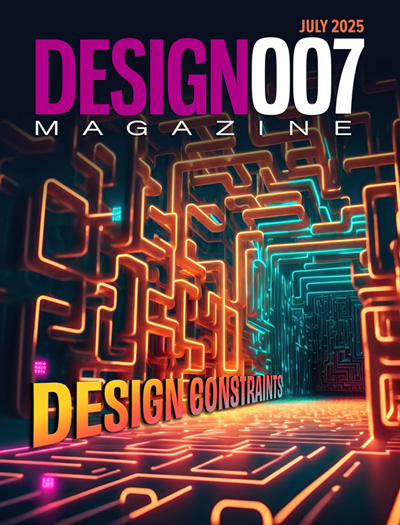-

- News
- Books
Featured Books
- design007 Magazine
Latest Issues
Current Issue
Signal Integrity
If you don’t have signal integrity problems now, you will eventually. This month, our expert contributors share a variety of SI techniques that can help designers avoid ground bounce, crosstalk, parasitic issues, and much more.

Proper Floor Planning
Floor planning decisions can make or break performance, manufacturability, and timelines. This month’s contributors weigh in with their best practices for proper floor planning and specific strategies to get it right.

Showing Some Constraint
A strong design constraint strategy carefully balances a wide range of electrical and manufacturing trade-offs. This month, we explore the key requirements, common challenges, and best practices behind building an effective constraint strategy.
- Articles
- Columns
- Links
- Media kit
||| MENU - design007 Magazine
A Potpourri of Design PD Classes
May 14, 2024 | Kelly Dack, I-Connect007Estimated reading time: 2 minutes
What is invention without innovation? What is innovation without capability? What is capability without standards and guidelines? What are standards and guidelines without the design and manufacturing stakeholders who produce them?
Folks say that invention involves the creation of things entirely new, while innovation is the process of improving the creations or finding new ways to use them. This observation holds true in all realms of PCB design. However, PCB designers, seated at PCB design workstations with very powerful CAD tools at hand, often misunderstand the concept of invention. Like a new musician making a lead error in a blues riff will refer to off-color notes as “jazz,” many new PCB designers not checking in with supplier capabilities will consider their work an “invention.”
A mistake is a mistake. DFM is a step in the innovation process, which is a necessary part of design. If new materials or processes do not exist, applying the concept of invention involves long timelines and astronomical financial backing, which must occur in order to reach the goals of a new product concept.
On Sunday, April 7, I attended a “design for” Professional Development session taught by Dale Lee. Presented as a two-part morning and afternoon class, Dale covered some very important DFs: design for manufacture (DFM), design for reliability (DFR), and design for assembly (DFA), referred to holistically as DFX (design for excellence). Lee gave many examples that stressed the importance of following industry standards and guidelines in the design of printed boards and assemblies. He stressed the importance of becoming familiar with common materials, machinery, and processes the PCB industry uses in order to “design for” measured success needed by the industry in order to provide measurable quality, performance, and reliability.
Later that morning, I bounced over to the “Ask the Flexperts” PD sessions featuring Mark Finstad and Nick Koop from TTM. Both innovators in their own rights, this Flexpert tag team was able to cover all aspects of flex and rigid-flex design principles to not only confirm industry-proven design methodology but follow up with tangible, expert, manufacturing stakeholder responses from TTM to illustrate what designers can do to improve their future flex designs. The two generously provided all attendees with a tote ring of flex circuit reference material, which can serve as a tactile guide in determining how flex structures behave mechanically.
To read this entire article, which appeared in the 2024 issue of Show & Tell Magazine, click here.
Testimonial
"Our marketing partnership with I-Connect007 is already delivering. Just a day after our press release went live, we received a direct inquiry about our updated products!"
Rachael Temple - AlltematedSuggested Items
ASM Technologies Limited signs MoU with the Guidance, Government of Tamilnadu to Expand Design-Led Manufacturing capabilities for ESDM
09/15/2025 | ASM TechnologiesASM Technologies Limited, a pioneer in Design- Led Manufacturing in the semiconductor and automotive industries, announced signing of Memorandum of Understanding (MoU) with the Guidance, Government of Tamilnadu whereby it will invest Rs. 250 crores in the state to expand its ESDM related Design-Led Manufacturing and precision engineering capacity. ASM Technologies will acquire 5 acres of land from the Government of Tamilnadu to set up a state-of-the-art design facility in Tamil Nadu's growing technology manufacturing ecosystem, providing a strong strategic advantage and long-term benefits for ASM.
Variosystems Strengthens North American Presence with Southlake Relaunch 2025
09/15/2025 | VariosystemsVariosystems celebrated the relaunch of its U.S. facility in Southlake, Texas. After months of redesign and reorganization, the opening marked more than just the return to a modernized production site—it was a moment to reconnect with our teams, partners, and the local community.
Deca, Silicon Storage Technology Announce Strategic Collaboration to Enable NVM Chiplet Solutions
09/11/2025 | Microchip Technology Inc.As traditional monolithic chip designs grow in complexity and increase in cost, the interest and adoption of chiplet technology in the semiconductor industry also increases.
I-Connect007 Launches New Podcast Series on Ultra High Density Interconnect (UHDI)
09/10/2025 | I-Connect007I-Connect007 is excited to announce the debut of its latest podcast series, which shines a spotlight on one of the most important emerging innovations in electronics manufacturing: Ultra-High-Density Interconnect (UHDI). The series kicks off with Episode One, “Ultra HDI: What does it mean to people? Why would they want it?” Host Nolan Johnson is joined by guest expert John Johnson, Director of Quality and Advanced Technology at American Standard Circuits (ASC).
Global Citizenship: Together for a Perfect PCB Solution
09/10/2025 | Tom Yang -- Column: Global CitizenshipIf there’s one thing we’ve learned in the past few decades of electronics evolution, it’s that no region has a monopoly on excellence. Whether it’s materials science breakthroughs in Europe, manufacturing efficiencies in China, or design innovations in Silicon Valley, the PCB industry thrives on collaboration.


